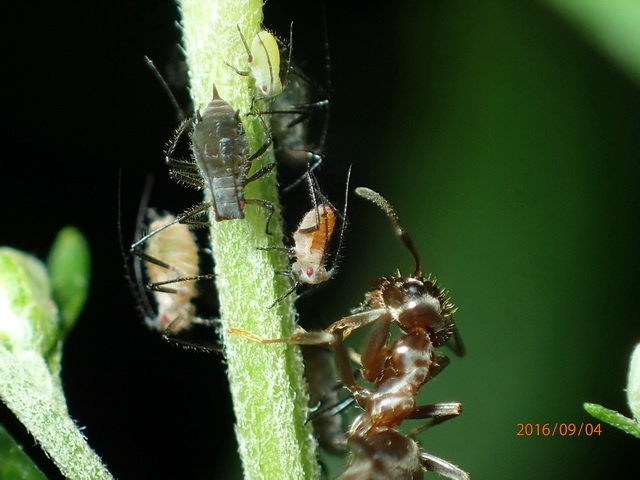Thanks to tending ants, mixed aphid colonies persist
The aphid milking ant Lasius japonicus ensures long-lasting coexistence of two colour morphs of the mugwort aphid, from which it harvests honeydew, Saori Watanabe and colleagues write. Without intervention, its favourite colour would be displaced.
Like many other ants, the Asian ant Lasius japonicus has a mutualistic relationship with aphids. The aphids suck sap from their host plant and excrete excess sugars, dissolved in a liquid: honeydew. The ant fights off their natural enemies and harvests (‘milks’) the sugary honeydew. One of its mutualistic partners is the Japanese mugwort aphid, Macrosiphoniella yomogicola, which lives on mugwort, a common plant of Europe and Asia. The protection by the ant is of crucial importance to the aphids; each colony will fall victim to its enemies if not protected.
Quality
The mugwort aphid occurs in different colours, with red and green as the most common types; large green specimens will turn black. The ant has a preference for the green morph, Saori Watanabe and colleagues show, because it excretes a higher quality honeydew. But as a consequence, the red morph, which retains a larger proportion of the sugars that it obtains from the host plant, can reproduce at a higher rate. All aphids are females that reproduce parthenogenetically, their young being clones of their mother. Red aphids produce red daughters, green aphids green daughters. The green morph runs a risk to be displaced by the red one, which multiplies faster.
But, as it turns out, the ants prevent this from happening. The researchers show that the red aphids indeed are able to multiply faster than the green ones. As a consequence, in laboratory experiments, the proportion of green aphids in a mixed colony decreased, but only if the researchers withheld attending ants. If, however, ants were allowed to join the aphids, the reproduction rate of the green morph increased, and the green aphids now reproduced as fast as the red aphids. Thus, in the presence of ants, the proportion between green and red morphs was stable.
It is not clear how the ants improve the reproduction rate of the green aphids, but it saves the green morph from local extinction.
Winter
In the field, almost all colonies are mixed. It is understandable that no pure red colonies are to be found. No ant would be interested in such colony, which produces only low quality honeydew, so it would be lost. But why don’t green colonies exist? Why wouldn’t the ants remove the red aphids from a mixed colony by eating them, so that only high quality honeydew would be produced?
Apparently, the presence of red aphids is advantageous for some reason. That has to do with the winter period, the researchers suggest. At the end of the season, the aphids give birth to daughters and sons, which mate and produce fertilized eggs that can overwinter if the host plant survives. However, after flowering in autumn, mugwort dies off. The researchers hypothesize that red aphids may suppress flowering, so that the plant persists. They are now going to test that idea.
Need each other
It would mean that the ant needs both aphid morphs, the green one for high quality honeydew, the red one to maintain the colony to the next season. It would also mean that the two types of aphids need each other. The red morph cannot do without the green one, which attracts attending ants, and the green morph cannot do without the red one, which prevents the host plant from dying off in winter.
But as dependent the aphid morphs may be on each other, they cannot live together for a long time without the ant interfering.
Willy van Strien
Photo: aphid tending ant Lasius japonicus and two colour morphs of Macrosiphoniella yomogicola. ©Ryota Kawauchiya
Bronnen:
Watanabe, S., J. Yoshimura & E. Hasegawa, 2018. Ants improve the reproduction of inferior morphs to maintain a polymorphism in symbiont aphids. Scientific Reports 8: 2313. Doi: 10.1038/s41598-018-20159-w
Watanabe, S., T. Murakami, J. Yoshimura & E. Hasegawa, 2016. Color polymorphism in an aphid is maintained by attending ants. Science Advances 2: e1600606. Doi: 10.1126/sciadv.1600606
